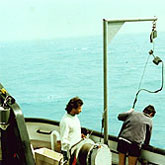What Is A Coccolithophore?
 Like any other type of phytoplankton, coccolithophores are one-celled marine plants that live in large numbers throughout the upper layers of the ocean. Unlike any other plant in the ocean, coccolithophores surround themselves with a microscopic plating made of limestone (calcite). These scales, known as coccoliths, are shaped like hubcaps and are only three one-thousandths of a millimeter in diameter. What coccoliths lack in size they make up in volume. At any one time a single coccolithophore is attached to or surrounded by at least 30 scales. Additional coccoliths are dumped into the water when the coccolithophores multiply asexually, die or simply make too many scales. In areas with trillions of coccolithophores, the waters will turn an opaque turquoise from the dense cloud of coccoliths. Scientists estimate that the organisms dump more than 1.5 million tons (1.4 billion kilograms) of calcite a year, making them the leading calcite producers in the ocean.
Like any other type of phytoplankton, coccolithophores are one-celled marine plants that live in large numbers throughout the upper layers of the ocean. Unlike any other plant in the ocean, coccolithophores surround themselves with a microscopic plating made of limestone (calcite). These scales, known as coccoliths, are shaped like hubcaps and are only three one-thousandths of a millimeter in diameter. What coccoliths lack in size they make up in volume. At any one time a single coccolithophore is attached to or surrounded by at least 30 scales. Additional coccoliths are dumped into the water when the coccolithophores multiply asexually, die or simply make too many scales. In areas with trillions of coccolithophores, the waters will turn an opaque turquoise from the dense cloud of coccoliths. Scientists estimate that the organisms dump more than 1.5 million tons (1.4 billion kilograms) of calcite a year, making them the leading calcite producers in the ocean.
Most phytoplankton need both sunlight and nutrients from deep in the ocean. The ideal place for them is on the surface of the ocean in an area where plenty of cooler, nutrient-carrying water is upwelling from below. In contrast, the coccolithophores prefer to live on the surface in still, nutrient-poor water in mild temperatures. Coccolithophores do not compete well with other phytoplankton. Yet unlike their cousins, coccolithophores do not need a constant influx of fresh food to live. They often thrive in areas where their competitors are starving. Typically, once they are in a region, they dominate and become more than 90 percent of the phytoplankton in the area.
Coccolithophores live mostly in subpolar regions. Some other places where blooms occur regularly are the northern coast of Australia and the waters surrounding Iceland. In the past two years, large blooms of coccolithophores have covered areas of the Bering Sea. This surprises many scientists since the Bering Sea is normally a nutrient-rich body of water. Coccolithophores are not normally harmful to other marine life in the ocean. The nutrient-poor conditions that allow the coccolithophores to exist will often kill off much of the larger phytoplankton. Many of the smaller fish and zooplankton that eat normal phytoplankton also feast on the coccolithophores. In nutrient-poor areas where other phytoplankton are scarce, the coccolithophores are a welcome source of nutrition.
About the Author
NASA NASA Earth Observatory
 NASA Earth Observatory is an online publishing outlet for NASA which was created in 1999. It is the principal source of satellite imagery and other scientific information pertaining to the climate and the environment which are being provided by NASA for consumption by the general public.
NASA Earth Observatory is an online publishing outlet for NASA which was created in 1999. It is the principal source of satellite imagery and other scientific information pertaining to the climate and the environment which are being provided by NASA for consumption by the general public.


